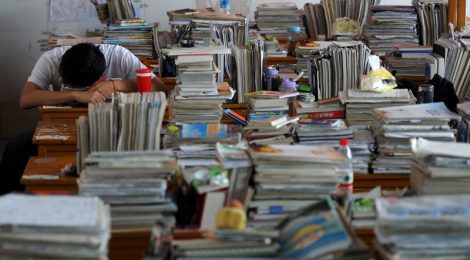
China’s most stressful week: 9,4 million students take the Gaokao
China’s most gruelling academic exam took place this week: 9,4 million Chinese students started the annual two-day nationwide test on Wednesday. Generally called 高考gaokao, which literally means “high test,” it is China’s national higher education entrance examination, a test high school graduates need to pass if they want to continue their education, and which can arguably make or break one’s future in China: it determines whether the students will be admitted to university, to which institution, and consequently what careers they can expect to pursue.
The fiercely competitive test is seen as key to social mobility: especially for those coming from poor areas, where possessing a degree can make the real different to access a “white-collar job,” the gaokao can represent a make-or-break opportunity.
The gaokao was introduced in 1952 as the first standardised examination in China. Three are the compulsory subjects: Chinese, mathematics and English, plus a comprehensive subject depending on whether the major chosen is in liberal arts or sciences. The gaokao was then halted in 1966 with the start of Cultural Revolution, as schools stopped teaching and young people were sent to the countryside to “learn from the peasants.” Those who would have graduated between 1966 and 1968 are generally referred to as 老三届 laosanjie – which means the three old classes – who are the ones who went through the most critical heights of Chairman Mao Zedong’s call for revolution.
In 1968 universities reopened, but the selection of students to access higher education was based on the recommendations of the belonging communist work unit, and was not granted to those who could not prove genuine proletarian origins. Five years later, a test was introduced to evaluate the candidates besides the recommendations, but it was assessed as elitist and finally not counted in for the university admissions.

It took 14 years for the gaokao to be restored in China’s education system: in December 1977, 5,7 million Chinese took the exam, with only 5 percent being admitted into college. That year, most of the candidates were already in their 20s or even 30s, including many who are currently influential people, both in politics or in the cultural realm, such as Premier Li Keqiang. In 2001, an age restriction for the candidates was removed, and 2008 signed a record of 10,5 million candidates, number which has been steadily declining since then.
According to Xinhua state news agency, only the 40 percent of the students taking the exam will succeed and enrol into a university. However, interesting exceptions exist, such as Maotanchang Middle School, which praises itself with a percentage of 80 to 90 of its students reaching college education since year 2010. Here, with the approaching of the test, the school organises ceremonies to pray for good luck, incense is burnt, and students and their families release in the sky floating lanterns with messages for the big day.
The whole China is affected by the test: local governments restrict traffic near the test centres, square dancers voluntarily stop practicing and noisy constructions sites are closed the days before the test. There have been cases of parents blocking the roads to make sure their sons’ performance would not been compromised by the noise of the traffic.
This system of selection has been criticised for putting students under too much pressure and for taking a comprehensive approach to education. Also, migrant workers have been lamenting the fact that enrolment quota are distributed according to household registration, in so doing excluding these families’ children to the country’s top universities in Beijing and Shanghai.




